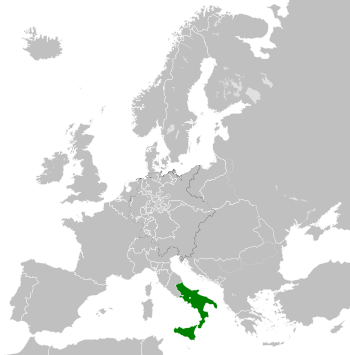Kingdom of the Two Sicilies facts for kids
Quick facts for kids
Kingdom of the Two Sicilies
Regno delle Due Sicilie
|
|||||||||||
|---|---|---|---|---|---|---|---|---|---|---|---|
| 1816–1861 | |||||||||||
|
|
|||||||||||

Location of the Kingdom of the Two Sicilies within Europe in 1839.
|
|||||||||||
| Capital | Palermo (1816–1817) Naples (1817–1861) |
||||||||||
| Religion | Roman Catholicism | ||||||||||
| Government | Absolute monarchy (1816–1848; 1849–1861) Constitutional monarchy (1848–1849) |
||||||||||
| King | |||||||||||
|
• 1816–1825
|
Ferdinand I (first) | ||||||||||
|
• 1859–1861
|
Francis II (last) | ||||||||||
| History | |||||||||||
|
• Edict of Ferdinand IV of Naples
|
12 December 1816 | ||||||||||
|
• Garibaldi's landing in Sicily
|
5 May 1860 | ||||||||||
| 17 March 1861 | |||||||||||
| Area | |||||||||||
| 1860 | 111,900 km2 (43,200 sq mi) | ||||||||||
| Population | |||||||||||
|
• 1860
|
8,703,000 | ||||||||||
|
|||||||||||
| Today part of | |||||||||||
The Kingdom of the Two Sicilies was the largest of the states of Italy before the Italian unification. It was formed as a union of the Kingdom of Sicily and the Kingdom of Naples, which collectively had long been called the "Two Sicilies".
The Kingdom of the Two Sicilies lasted from 1815 until 1860, when it was joined by the Kingdom of Sardinia to form the Kingdom of Italy in 1861. The capitals of the Two Sicilies were in Naples and in Palermo. The kingdom extended over the Mezzogiorno (the southern part of mainland Italy) and the island of Sicily.
The integration of the Kingdom of the Two Sicilies into the Kingdom of Italy changed the status of Naples forever, poverty meant that, throughout Naples and Southern Italy, thousands decided to leave in search of a better future. Many went to the new world.
The kingdom was heavily agricultural, like the other Italian states; the church owned 50–65% of the land by 1750.
Background
The Kingdom of the Two Sicilies resulted from the re-unification of the Kingdom of Sicily with the Kingdom of Naples, by King Alfonso V of Aragon in 1442. The two states had functioned as separate realms since the War of the Sicilian Vespers in 1282. At the death of King Alfonso in 1458, the kingdom again became divided between his brother John II of Aragon, who kept the island of Sicily, and his son Ferdinand, who became King of Naples.
In 1501, King Ferdinand II of Aragon, son of John II, conquered Naples and reunified the two kingdoms under the authority of the newly united Spanish throne, until the War of the Spanish Succession. At the end of that war, the Treaty of Utrecht in 1713 granted Sicily to the Duke of Savoy until the Treaty of Rastatt in 1714 left Naples to the Emperor Charles VI. In 1720 the Emperor and Savoy exchanged Sicily for Sardinia, thus reuniting Naples and Sicily.
In 1734, Charles, Duke of Parma, son of Philip V of Spain, took the Sicilian crown from the Austrians and became Charles VII & V, giving Parma to his younger brother, Philip. In 1759, Charles became King Carlos III of Spain and resigned Sicily and Naples to his younger son, who became Ferdinand III of Sicily and Ferdinand IV of Naples, later crowned Ferdinand I of the Two Sicilies in 1816. Apart from an interruption under Napoleon, the Kingdom of the Two Sicilies remained under the Bourbon line (Bourbon Duo-Sicilie) continually until 1860.
In January 1799, Napoleon Bonaparte, in the name of the French Republic, captured Naples and proclaimed the Parthenopaean Republic, a French client state, as successor to the kingdom. King Ferdinand fled from Naples to Sicily until June of that year.
In 1806, Napoleon, by then French Emperor, again dethroned King Ferdinand and appointed his brother, Joseph Bonaparte, as King of Naples. In 1808 Napoleon moved Joseph to Spain and appointed their brother-in-law, Joachim Murat, as King of the Two Sicilies, though this only meant control of the mainland portion of the kingdom. Throughout this Napoleonic interruption, King Ferdinand remained in Sicily, with Palermo as his capital. The Congress of Vienna restored King Ferdinand in 1815.
Several rebellions took place on the island of Sicily against King Ferdinand II (reigned 1830–1859), but the end of the kingdom came only with the Expedition of the Thousand in 1860, led by Garibaldi – an icon of Italian unification – with the support of the House of Savoy and their Kingdom of Piedmont-Sardinia.
The expedition resulted in a striking series of defeats for the Sicilian armies. After the capture of Palermo and Sicily, Garibaldi moved towards Naples. The last battles took place at Volturnus in 1860 and at the siege of Gaeta, where King Francis II (reigned 1859–1861) had sought shelter, hoping for French help, which never came.
The last towns to resist Garibaldi's expedition, Messina and Civitella del Tronto, surrendered on 13 March 1861 and on 20 March 1861. The Kingdom of the Two Sicilies dissolved and the new Kingdom of Italy, founded in the same year annexed its territory. The fall of the Sicilian aristocracy in the face of Garibaldi's invasion forms the subject of the novel The Leopard by Giuseppe Tomasi di Lampedusa and its film adaptation.
Images for kids
-
Cappella Palatina, church of first unifier Roger II of Sicily.
-
Portrait of Ferdinand II, 1844
-
The Teatro Reale di San Carlo in Naples 1830 as rebuilt after the 1816 fire
-
Silver coin: 120 grana Ferdinando II - 1834
-
Contadini from the Neapolitan countryside by Filippo Palazzi, 1840
-
Ferdinand I, 1816–1825
-
Ferdinand II, 1830–1859
See also
 In Spanish: Reino de las Dos Sicilias para niños
In Spanish: Reino de las Dos Sicilias para niños






















